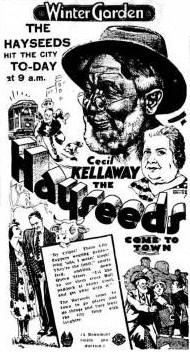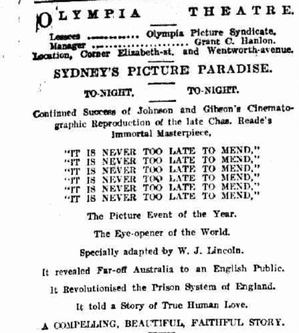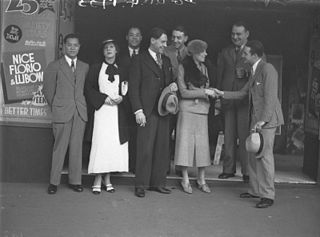Related Research Articles

Thunderbolt is a 1910 Australian feature film based on the life of the bushranger Captain Thunderbolt. It was the directorial debut of John Gavin who later claimed it was the first "four-reel movie" made in Australia. It has also been called the first film made in New South Wales.

George Marlow was an Australian theatrical entrepreneur born in London of Jewish extraction, noted for bringing melodrama and pantomime to Sydney audiences in the early 1900s. His name has been frequently mis-spelled as "George Marlowe".

The Hayseeds is a 1933 Australian musical comedy from Beaumont Smith. It centres on the rural family, the Hayseeds, about whom Smith had previously made six silent films, starting with Our Friends, the Hayseeds (1917). He retired from directing in 1925 but decided to revive the series in the wake of the box office success of On Our Selection (1932). It was the first starring role in a movie for stage actor Cecil Kellaway.

Moonlite is a 1910 Australian bushranger film about Captain Moonlite, played by John Gavin, who also directed for producer H.A. Forsyth. It was also known as Captain Moonlite and is considered a lost film.

The Mark of the Lash is a 1911 Australian silent film. It is a convict-era melodrama made by the husband-and-wife team of John and Agnes Gavin.

His Convict Bride is a 1918 Australian silent film from the team of John and Agnes Gavin. It was a convict-era melodrama.

Satan in Sydney is a 1918 Australian melodrama from director Beaumont Smith. It was his first movie which was not about the rural family, the Hayseeds. It is considered a lost film.

Peter Vernon's Silence is a 1926 Australian silent film directed by Raymond Longford. It was the last film on which Lottie Lyell worked prior to her death in December 1925. It is considered a lost film.

It Is Never Too Late to Mend is a 1911 Australian feature-length silent film written and directed by W. J. Lincoln.
The Luck of Roaring Camp is a 1911 Australian feature-length film directed by W. J. Lincoln now considered a lost film. It was highly regarded in its day, in part because it was based on a play that was popular with audiences.
What Women Suffer is a 1911 Australian silent film directed by Alfred Rolfe. It is a Victorian melodrama, complete with a climax where a little child is placed on a moving saw bench and is considered a lost film.
The Monk and the Woman is a 1917 Australian silent film directed by Franklyn Barrett. It is considered to be lost.
Angel of his Dreams is an Australian film directed by George Marlow about a woman who seduces a clergyman.

The New Tivoli Theatre, Sydney, previously known as the Adelphi Theatre and the Grand Opera House, was a theatre and music hall at 329, Castlereagh Street, Sydney, Australia, which was long at the heart of the Tivoli circuit.
The Australian Photo-Play Company was a short-lived but highly productive Australian film production company which operated from 1911 to 1912.

George Willoughby Dowse, professionally known as "George Willoughby", was an English comic actor and theatre manager who had a substantial career in Australia.
Charles Darrell was an English playwright who specialized in melodrama.
Wilton Welch was an Australian comic actor and dramatist, husband and collaborator of Louise Carbasse, best known as Louise Lovely.
The Girl Who Loved a Soldier was an Australian stage play written by Wilton Welch. It has been credited as the first Australian play to be set in a city.
Humping the Bluey is a 1911 Australian stage play by Dora Mostyn produced by George Marlow. It was one of the last plays in the "bushranging cycle" of Australian playwriting.
References
- ↑ "Advertising". The Referee . Sydney. 8 November 1911. p. 16. Retrieved 8 June 2015– via National Library of Australia.
- ↑ "Marlow Again in Entertainment Field". Everyones. 24 March 1928. p. 3.
- ↑ "Marlow Again in Entertainment Field.", Everyones., 5 (316 (24 March 1926)), Sydney: Everyones Ltd, nla.obj-577683222, retrieved 9 March 2024– via Trove
- ↑ "DRIVING A GIRL TO DESTRUCTION". The Sydney Morning Herald . 19 June 1911. p. 5. Retrieved 9 April 2012– via National Library of Australia.
- ↑ n "ENTERTAINMENTS". The Brisbane Courier . 18 September 1911. p. 5. Retrieved 9 April 2012– via National Library of Australia.
- 1 2 Andrew Pike and Ross Cooper, Australian Film 1900–1977: A Guide to Feature Film Production, Melbourne: Oxford University Press, 1998, 28
- ↑ "ADELPHI THEATRE". The Sydney Morning Herald . 12 June 1911. p. 4. Retrieved 9 April 2012– via National Library of Australia.
- ↑ "Advertising". The Morning Bulletin . Rockhampton, Qld. 4 December 1912. p. 2. Retrieved 9 April 2012– via National Library of Australia.
- ↑ ""DRIVING A GIRL TO DESTRUCTION."". The Northern Miner . Charters Towers, Qld. 4 April 1916. p. 2. Retrieved 9 April 2012– via National Library of Australia.